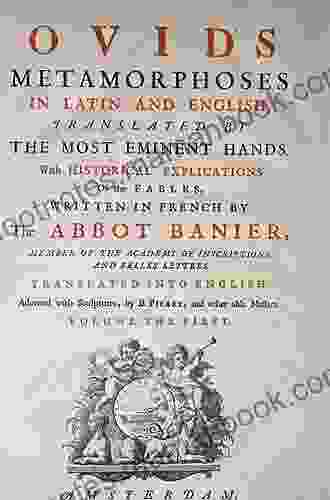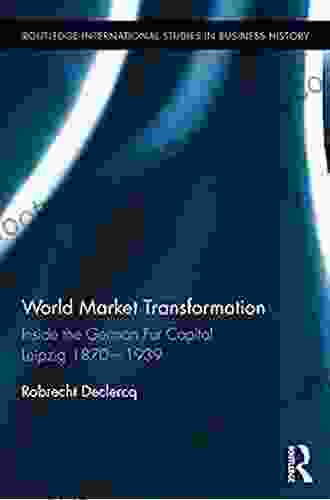Inside the German Fur Capital: Leipzig, 1870 and 1939

Leipzig was the center of the German fur trade from the late 19th century to the mid-20th century. During this time, the city was home to a thriving fur industry, with hundreds of furriers and fur traders operating in the city. Leipzig was also the site of the world's largest fur fair, which was held annually in the city.
The fur trade in Leipzig began in the 19th century, when the city became a major center for the fur trade in Europe. Leipzig's central location and its proximity to major fur-producing regions in Russia and Siberia made it an ideal location for the fur trade. By the late 19th century, Leipzig was the leading fur trade center in Germany, and it was home to a large number of furriers and fur traders.
5 out of 5
| Language | : | English |
| File size | : | 2680 KB |
| Text-to-Speech | : | Enabled |
| Screen Reader | : | Supported |
| Enhanced typesetting | : | Enabled |
| Word Wise | : | Enabled |
| Print length | : | 248 pages |
The fur trade in Leipzig reached its peak in the early 20th century. During this time, Leipzig was the world's largest fur trade center, and it was home to over 1,000 furriers and fur traders. The city's fur fair was also the world's largest, and it attracted buyers from all over the world.
However, the fur trade in Leipzig began to decline in the mid-20th century. The decline of the fur trade was due to a number of factors, including the rise of synthetic furs, the changing fashion trends, and the increasing awareness of animal rights. By the 1970s, the fur trade in Leipzig had largely disappeared.
The Fur Trade in Leipzig
The fur trade in Leipzig was a complex and multifaceted industry. The fur trade involved a number of different processes, including the trapping of animals, the processing of fur, and the sale of fur products.
The trapping of animals was the first step in the fur trade. Animals were trapped in a variety of ways, including trapping, snaring, and shooting. Trapping was the most common method of trapping animals, and it was used to trap a variety of animals, including foxes, rabbits, and minks.
Once animals were trapped, they were then processed into fur. The processing of fur involved a number of steps, including skinning, fleshing, and tanning. Skinning was the process of removing the animal's skin from its body. Fleshing was the process of removing the flesh from the skin. Tanning was the process of preserving the skin and making it suitable for use in fur products.
Once fur was processed, it was then sold to furriers and fur traders. Furriers were responsible for making fur products, such as fur coats, hats, and gloves. Fur traders were responsible for selling fur products to consumers.
The Fur Fair in Leipzig
The fur fair in Leipzig was the world's largest fur trade event. The fair was held annually in the city, and it attracted buyers from all over the world. The fair was an important opportunity for furriers and fur traders to showcase their products and to meet with potential customers.
The fur fair in Leipzig was first held in 1870. The fair was initially a small event, but it quickly grew in size and importance. By the early 20th century, the fair was the world's largest fur trade event. The fair was held in a large exhibition hall in the city center, and it attracted thousands of visitors each year.
The fur fair in Leipzig was a major event in the city's social calendar. The fair was a time for furriers and fur traders to socialize and to celebrate the fur trade. The fair was also a time for fashion shows and other events.
The fur fair in Leipzig was a major economic event for the city. The fair generated millions of dollars in revenue for the city each year. The fair also helped to boost the city's tourism industry.
The Decline of the Fur Trade in Leipzig
The fur trade in Leipzig began to decline in the mid-20th century. The decline of the fur trade was due to a number of factors, including the rise of synthetic furs, the changing fashion trends, and the increasing awareness of animal rights.
The rise of synthetic furs was a major factor in the decline of the fur trade. Synthetic furs were cheaper and more durable than real fur, and they were also more environmentally friendly. As a result, consumers began to switch to synthetic furs, and the demand for real fur declined.
The changing fashion trends also contributed to the decline of the fur trade. In the early 20th century, fur coats were a popular fashion item. However, by the mid-20th century, fur coats had fallen out of fashion. As a result, the demand for fur coats declined, and the fur trade suffered.
The increasing awareness of animal rights also contributed to the decline of the fur trade. In the mid-20th century, there was a growing awareness of the animal cruelty involved in the fur trade. This awareness led to protests and boycotts of the fur trade. As a result, the demand for fur products declined, and the fur trade suffered.
By the 1970s, the fur trade in Leipzig had largely disappeared. The fur fair in Leipzig was closed in 1971, and the city's fur industry collapsed. Today, there are only a few furriers and fur traders operating in Leipzig.
The fur trade in Leipzig was a major industry for over a century. However, the fur trade began to decline in the mid-20th century due to a number of factors, including the rise of synthetic furs, the changing fashion trends, and the increasing awareness of animal rights. By the 1970s, the fur trade in Leipzig had largely disappeared. Today, there are only a few furriers and fur traders operating in Leipzig.
5 out of 5
| Language | : | English |
| File size | : | 2680 KB |
| Text-to-Speech | : | Enabled |
| Screen Reader | : | Supported |
| Enhanced typesetting | : | Enabled |
| Word Wise | : | Enabled |
| Print length | : | 248 pages |
Do you want to contribute by writing guest posts on this blog?
Please contact us and send us a resume of previous articles that you have written.
 Top Book
Top Book Novel
Novel Fiction
Fiction Nonfiction
Nonfiction Literature
Literature Paperback
Paperback Hardcover
Hardcover E-book
E-book Audiobook
Audiobook Bestseller
Bestseller Classic
Classic Mystery
Mystery Thriller
Thriller Romance
Romance Fantasy
Fantasy Science Fiction
Science Fiction Biography
Biography Memoir
Memoir Autobiography
Autobiography Poetry
Poetry Drama
Drama Historical Fiction
Historical Fiction Self-help
Self-help Young Adult
Young Adult Childrens Books
Childrens Books Graphic Novel
Graphic Novel Anthology
Anthology Series
Series Encyclopedia
Encyclopedia Reference
Reference Guidebook
Guidebook Textbook
Textbook Workbook
Workbook Journal
Journal Diary
Diary Manuscript
Manuscript Folio
Folio Pulp Fiction
Pulp Fiction Short Stories
Short Stories Fairy Tales
Fairy Tales Fables
Fables Mythology
Mythology Philosophy
Philosophy Religion
Religion Spirituality
Spirituality Essays
Essays Critique
Critique Commentary
Commentary Glossary
Glossary Bibliography
Bibliography Index
Index Table of Contents
Table of Contents Preface
Preface Introduction
Introduction Foreword
Foreword Afterword
Afterword Appendices
Appendices Annotations
Annotations Footnotes
Footnotes Epilogue
Epilogue Prologue
Prologue Pedro Wilks
Pedro Wilks Amy Vatne Bintliff
Amy Vatne Bintliff Ed Butowsky
Ed Butowsky Marata Eros
Marata Eros Mark Tepper
Mark Tepper Jean Paul Sartre
Jean Paul Sartre Kahlil Gibran
Kahlil Gibran Dane Huckelbridge
Dane Huckelbridge Nick Cole
Nick Cole Creek Stewart
Creek Stewart Scott Cunningham
Scott Cunningham Viktor Dick
Viktor Dick Tasha Waller
Tasha Waller Kenneth Michael Plaisance
Kenneth Michael Plaisance Davina Mackail
Davina Mackail Jacqueline Winspear
Jacqueline Winspear Keith Gilyard
Keith Gilyard S A Cosby
S A Cosby Kylie Day
Kylie Day Crystal Daniels
Crystal Daniels
Light bulbAdvertise smarter! Our strategic ad space ensures maximum exposure. Reserve your spot today!

 Robert ReedA Comprehensive Exploration of the History, Teachings, and Cultural Impact of...
Robert ReedA Comprehensive Exploration of the History, Teachings, and Cultural Impact of... Pat MitchellFollow ·8.8k
Pat MitchellFollow ·8.8k Jaime MitchellFollow ·16.5k
Jaime MitchellFollow ·16.5k Theo CoxFollow ·12.8k
Theo CoxFollow ·12.8k Ryūnosuke AkutagawaFollow ·12.4k
Ryūnosuke AkutagawaFollow ·12.4k Leo TolstoyFollow ·4.6k
Leo TolstoyFollow ·4.6k Samuel WardFollow ·19.3k
Samuel WardFollow ·19.3k Amir SimmonsFollow ·9.8k
Amir SimmonsFollow ·9.8k Cody RussellFollow ·7.8k
Cody RussellFollow ·7.8k

 Colin Foster
Colin FosterBlacktop Wasteland: A Novel S A Cosby
In the vast literary landscape of...

 Curtis Stewart
Curtis StewartOvid's Metamorphoses: An Ancient Epic of Transformation...
Ovid's Metamorphoses is an epic poem...

 Adam Hayes
Adam HayesThe Elements of Piano Playing Op. 30: A Comprehensive...
: Unveiling...

 Patrick Hayes
Patrick HayesLee Marvin and The Long Night: A Tale of Vengeance, Grit,...
In the annals of Western cinema, few...

 Jermaine Powell
Jermaine PowellUnveiling the Alluring World of Romantic Thrillers,...
Prepare to delve into a...
5 out of 5
| Language | : | English |
| File size | : | 2680 KB |
| Text-to-Speech | : | Enabled |
| Screen Reader | : | Supported |
| Enhanced typesetting | : | Enabled |
| Word Wise | : | Enabled |
| Print length | : | 248 pages |












